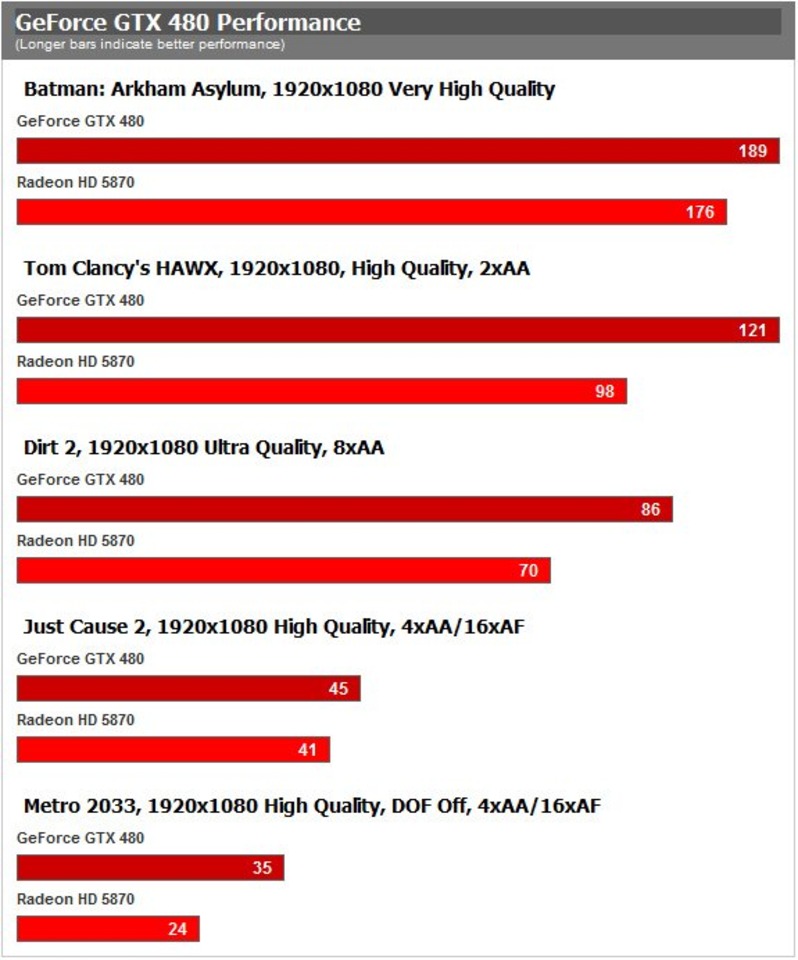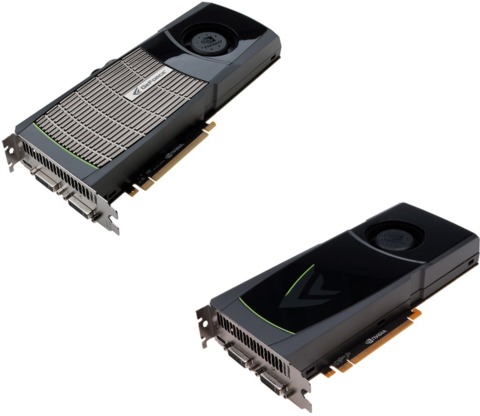Nvidia GeForce GTX 480 Hands-On Preview
Nvidia releases the GeForce GTX 480 and GeForce GTX 470. They're scorchers in more than one way.
Nvidia has been noticeably absent from the video card scene over the past few months. In the meantime, ATI launched an entire DirectX11 lineup, top to bottom, and then had time to funnel some chips into the notebook scene. The Santa Clara GPU manufacturer should have combated ATI's Radeon 5000 series months ago, but delays tripped them up a bit. To make sure they weren't forgotten completely, Nvidia released details about the Fermi chip a few months back. The company now has the hardware to back up the paper. Nvidia unveiled the GeForce GTX 480 and the GeForce GTX 470, high-end cards that pack a big fiery punch in many ways. Unfortunately (also in a rather papery way) the cards won't hit retail until April 12.
The details:
GeForce GTX 480
480 Cores
700MHz Core
1536MB GDDR5 RAM
1848MHz RAM
250W
$499
GeForce GTX 470
448 Cores
607MHz Core Clock
1280MB GDDR5 RAM
1674MHz RAM
215W
$349
Down to the nitty-gritty, the GeForce 400 series uses what Nvidia refers to as graphics processing clusters (GPC) as its major building block. Within each of the GPCs we find four streaming multiprocessors (SM). An SM contains 32 cores built up of numerous parts. If we do the math we see that the GeForce GTX 480 (with its 480 cores) has 15 SMs, while the GTX 470 has 14 of them. In the world of computers, odd numbers stick out a lot. It's likely that Nvidia encountered yield issues and had to disable one unit to get working chips in sufficient quantity. If that's the case, we surmise that at a later date (once yields have improved) we'll see a GPU with 16 SMs in it. In turn, lower-end chips will likely follow at later dates with more cores lopped off.
Nvidia's new GPUs support DirectX11, 3D Vision Surround, and the usual array of bells and whistles like PhysX and SLI. 3D Vision Surround lets users connect three displays and enable 3D rendering at the same time. However, the feature was not functional for testing. Nvidia mentioned that 3D Vision Surround will go live with the release of the Nvidia Forceware 256 driver in April. We're guessing that the feature will also be functional for GeForce 200 series cards at that time as well. A dual-GPU SLI setup is required to run 3D Vision Surround, and that goes for both GeForce 400 series cards and GeForce 200 series cards.
In terms of home theater duties, the GeForce 400 series is no match for ATI's Radeon 5000 series. The latter can transfer Dolby TrueHD and DTS-HD, while the GeForce 400s manage to output only conventional Dolby Digital and DTS.
We have the GeForce 480 GTX in-house for testing. Our reference GeForce GTX 480 has three outputs: 2 x DVI, and 1 x mini-HDMI. However, only two outputs can be used simultaneously. For three-monitor output you will need an additional video card. 
In terms of size, the card is pretty much the same size as the Radeon HD 5870 and smaller than the dual-GPU Radeon HD 5970. Nvidia cards to date have used a plastic shroud that completely covers the business side of the card, but now it has been cut open to reveal a gigantic metal heatsink. Additional heat pipes run along the top to better distribute heat as well. Not a bad idea considering that the card gobbles up electricity. Using our open air test bed we saw temperatures soar up to 95 degrees Celsius; by comparison, our dual-GPU Radeon HD 5970 topped off at around 75 degrees Celsius under similar conditions.
Nvidia certainly didn't disappoint on the performance side of the equation. The GeForce GTX 480 outmaneuvers the Radeon HD 5870 at every turn in the games we tested. On average, the GeForce GTX 480 pulled away from the Radeon HD 5870 by 17 percent. No doubt about it, that makes the GeForce GTX 480 the fastest single GPU card on the market--at a price, of course. It eats up more power, produces more heat, and costs anywhere from $50 to $70 more than the Radeon HD 5870. The GeForce GTX 480 is also missing triple monitor support and modern home-theater capabilities. To take advantage of 3D Vision Surround you're also going to have to purchase two GeForce GTX 480s for the princely sum of $1,000. While the performance victory is clear from a single GPU perspective, the buying decision gets murky depending upon your needs.
Got a news tip or want to contact us directly? Email news@gamespot.com


Join the conversation